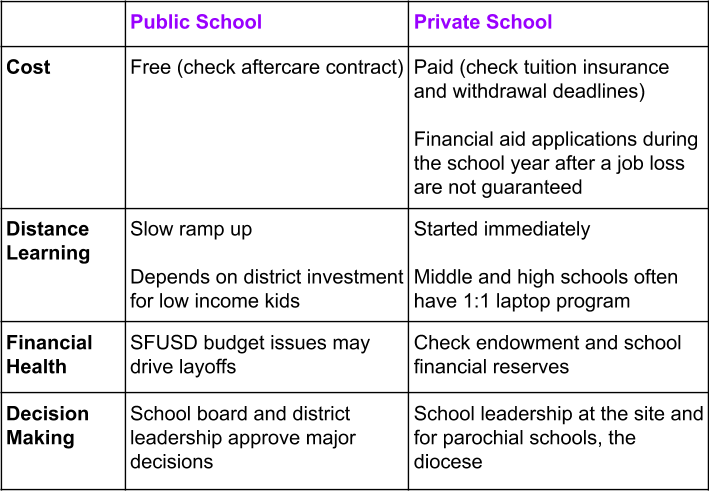Many clients asked, given the pandemic, should we put our child in public or private school? How does the pandemic and the subsequent the shelter-in-place, affect our decision?
Uncertainty Reins
How long? As we move into the second month of school closures, one thing is clear. We do not know how long the shelter-in-place or social distancing will last. Most expect public and private schools to remain closed until the end of the school year, but questions arise regarding the fall. Will schools open again in August, or will the closures continue either full time or intermittently until a vaccine is approved and available? If schools open in August, will they close again with a second wave of the virus? At Governor Newsom's most recent livestream, he discussed alternating school times to reduce class sizes, whereby kids would only go to school for the morning or the afternoon. There is no crystal ball, but generically, uncertainty is our situation.
Recession? Once households are allowed to return to school and work, will a longer term recession kick in? Many fear longer term impact from the shelter-in-place, with the unrecoverable losses driving less consumer and business spending. Hiring freezes are spreading among organizations even outside those closed, including tech companies. In addition to parents who’ve lost their livelihoods, employed parents fear losing their jobs. Will the economy face a recession, and, if so, how long will it take to recover?
School Decision Among the Uncertainty
With limited answers, we must make our decisions based on what we know right now, which is that the economy might face an extended recession, and next school year might have periods of distance learning. Like many, I suggest looking at the pros/cons as specific to your family.
Public or Charter School
The key advantage of public school is the price, free, if you don’t commit to aftercare or have an “out” on paying during school closures.
The challenges? Distance learning was slowed by the need to feed and provide devices and internet to low income families and other holistic needs; however, by the fall, the district might catch up. SFUSD spent most of its rainy day fund before the virus hit, and the closures have increased costs further, meaning the district is discussing layoffs. How those layoffs affect individual school sites or children remains to be seen.
Private School (Independent or Catholic/Parochial)
The advantages of private schools are higher resources and nimbleness due to leadership at the school site vs. a school district bureaucracy for approval. Most private schools implemented distance learning immediately as they began planning in January. As a result, they are further ahead in distance learning. Many private schools have lower student:teacher ratios, but not necessarily the space to spread out, so this will vary.
A disadvantage for private school will be the added stress of tuition, even if your family is on financial aid, and whether additional funds will be available if parents face job losses. Smaller or newer schools may not weather a recession, and so checking on the school’s endowment is wise. Read your contract to determine the cost to you if you drop out over the summer, and what are the rules of tuition insurance.
A Third Option
Begin in Public, and Transfer Later. For parents who cannot afford K-12 private, on top of university costs, middle school would be my priority for the expense. For most children, public school is a great option for elementary school. Many private middle schools add seats for 5th or 6th grade, and SFUSD class size increases in 4th grade, so transferring at 5th grade can avoid some years with bigger classes during the awkward preteen/early teen years and, at many privates, access Algebra I in 8th grade. For high school, SFUSD offers some excellent application-based schools, Lowell and Ruth Asawa School of the Arts, as well as the general high school program.
Factors Specific to Your Family
Each family needs to assess their family’s situation and decide what is the best fit for them. I’ve listed the largest factors below. Don’t be afraid to decide what is right for your family, even if your friends are making a different decision. As this article states, a period of extended distance learning will affect different kids differently.
Family Financial Security. If you expect your family’s income to decrease during a recession, worry about losing your income completely, and have limited savings, commiting to private school can increase your stress levels.
Child’s Grade Level. Younger children are less adaptable to distance learning and require more attention at home. Middle and high schoolers are more independent and count on quality education to move their learning ahead.
Child Specific Needs. SFUSD typically focuses on children in the middle of the bell curve. Gifted kids or those needing extra attention might benefit from the lower ratios in private schools. Kids with special needs are not always accepted in private schools, whereas public schools are required to meet their needs. Consult with an IEP Advocate if you do not yet have an IEP or 504 Plan. SFUSD math pathway in middle school does not include Algebra I. Families can look at outside math to overcome this issue, or look for private schools that offer Algebra I in 8th grade.
Need more help?
Vicky consults with families to help select public and private schools in San Francisco in an environment of non-judgment. Her own children have attended both public and private schools, and she believes that each has unique benefits. Email to learn more about her services or to ask for a referral to an IEP Advocate.


Comments